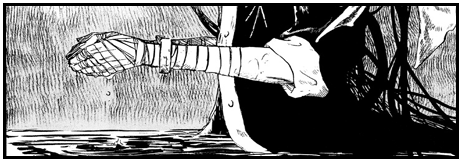
Baroque Shinto
To massively oversimplify, the Japanese religion of Shinto contains many principles concerned with flowing water and purity. According to Shinto, your actions should mirror the properties of flowing water, for water which flows is pure. Conversely, water that stagnates becomes polluted - a breeding pool for impurities such as parasites and disease. It is a source of illness, or as the Archangel equates it, “distortion”.
Several items and concepts in Baroque reference these principles, such as the Waste Water item or the "pure water" that Eliza seeks. Waste Water is described as "corrupted water", or more literally, "kegare water". 'Kegare' is a Shinto concept pertaining to a type of impurity that stains the very being of any person who comes into contact with it. This impurity often spreads via liquids that have ceased to flow (such as spilt blood). In game, ampoules filled with this stagnant Waste Water will make you weaker, but will make Grotesques stronger. This is because their delusions have caused them to reach a state of total emotional stagnation. It’s no coincidence that this stagnation breeds in the absence of motion-inducing chemicals like noradrenaline (which was removed from God in order to drive her mad). Adding more stagnation in the form of Waste Water makes these delusional, stagnant creatures even more distorted, and therefore more powerful.
In the PS1 port, the Coffin Man comments that there is "no pure water left in the world". As the player can clearly see, all the water outside has turned a sickly, stagnant green. Considering that Eliza and the Mind Reading Thing both confirm that the world itself is God's language, this means that water must be analogous to the flow of information through the world. This would be appropriate, as water comprises the majority of all living beings and is the source from which all life originally evolved. With the lifeblood of the planet having stagnated in this way, it is no wonder that the only wildlife that seems to have survived the Great Heat Wave are a variety of large parasitic worms. Even time itself has stagnated, as the protagonist finds himself locked in an endless cycle of death and resurrection with his dead twin.
Shinto traditions have fueled a lot of casual discrimination in Japan’s cultural subconscious (such as depicting women or disabled people as dangerous sources of impurity), and it is not uncommon to see these bigoted tropes in other Japanese video games and media. Baroque may make liberal use of Shinto in order to further illustrate concepts central to its plot, but the ending of the game appears to be a complete rebuttal of both these traditional beliefs and the history of prejudice towards disease and disability that they helped to inspire.
But this prejudice was influenced by far more than just Shinto traditions, as Japan is home to a blend of both native Shinto and imported Buddhist teachings. For this reason, it’s interesting to note that the Malkuth’s faith also appears to have drawn from various Buddhist beliefs. Buddhism is directly referenced when the Archangel asks the protagonist if they “wish to bring the world to the kalpa of nothingness” (localized to “Armageddon” in my translation). When the gluttonous Urim and Thummim begin assimilating with the Earth of Baroque’s anesthetized, insane god, they begin rejecting food and claiming that they have no "worldly desires" anymore - a term written identically to the “worldly desires” that keep one from attaining nirvana. The Sentry Angel also suggests that the protagonist will feel better if they “accept that [they’re] nobody”, which is a very Buddhist sentiment.
The Archangel manipulating the protagonist with ‘guilt from a sin he can’t remember’ is reminiscent of cruel Buddhist teachings which state that circumstances like disability and disease - or even being LGBTQIA+ - are punishments for sins committed in a forgotten past life. Such teachings also serve to inflict guilt in an effort to motivate people towards 'healing their sin’ (or rather karma) by dedicating themselves to Buddhist tenets. And as Buddhists seek to escape a perpetual cycle of personal reincarnation, so too must Baroque’s protagonist cease the endless reincarnation of the world. But whereas Buddhism promises an end to earthly suffering in nirvana, the ending of Baroque states that this world of suffering, disability, and distortion must be accepted, for such things are intrinsic to who we are.
These fears of being spiritually or karmically corrupted extend even further abroad, dovetailing seamlessly with the Malkuth’s more obvious Abrahamic inspirations. Concepts such as ‘guilt over a sin one can’t remember committing’ and ‘karma becoming tainted by earthly desires’ all have close parallels in Biblical tales of original sin and the damnation of immortal souls through temptation. And just like its Eastern counterparts, Abrahamic religion is all too often used to cast scorn on those whom its adherents view as impure.
Baroque’s rejection of these messages is an incredibly important one, for the influence of these traditions is far from harmless. For instance, “impurities” such as sickness and abnormality in all forms have been traditionally viewed by Japanese society as something to be hidden away and kept out of the public eye. But these biases far exceeded basic societal stigma, as starting in 1948, the Japanese government would forcibly sterilize 16,500 people in a eugenics campaign to eradicate any trace of hereditary disability. Even after this program shut down in 1996, the influence of this intense prejudice lived on in atrocities like the 2016 Sagamihara tragedy, in which a man killed 19 people and injured 26 others at a care facility for the disabled. The killer envisioned a world in which the disabled were euthanized, as to lift their ‘burden’ from society, and that such killings were “for the sake of Japan and world peace”. Despite occurring almost two decades after the release of “Baroque”, his motivations are chillingly similar to those of the Archangel. Both want to eradicate those they view as “distorted” in order to purify the world. But as we learn in the game’s finale - “Trying to purify the world [is], in itself, a distorted delusion.”
The term "Baroque" originally referred to a type of pearl. This is likely why Idea Sefirot closely resemble these gemstones. However, they also serve as a symbol of Baroque’s central moral, as pearls are formed around impurities. The impurity is an integral part of the pearl and not something that can be eradicated. Distortion - whether it be disease, disability, or even the delusions we form to cope with suffering - is a natural part of our world and is present in each and every one of us. As Urim and Thummim put it, “Everyone is distorted, so I think it’s a mistake to condemn anyone over their distortions.”
Additional Notes
-
Design documents confirm that “sick people” was a central theme in the game’s plot. This is the reason for so many of the character costumes including elements like bandages, gauze, and medical tubing.
-
Baroque’s roots may even extend to Gnostic interpretations of Judaism and Christianity, which feature a malevolent false god called the demiurge - a being who has ensnared humanity within a corrupted material universe that it created and actively maintains through the manipulation of Platonic idealism (the philosophy that directly inspired Idea Sephirot). But while Gnosticism claims that one must escape this distorted material universe created by its demiurgic usurper, Yonemitsu plainly states in his "Baroque World Guidance" interview that Baroque’s God of Creation and Preservation is the one true creator and that the distorted world this profane divinity preserves is both perfectly natural and something that should be accepted.
-
The retroactive addition of the Archangel’s infirmed sister in the PS1 port also draws from traditional prejudices against the sick and disabled. The Archangel in this revision is lashing out against this exact societal bias, as it led to his deformed sister wasting away in a dark room out of view from the public. It makes him a more sympathetic character, but inadvertently vilifies the cause by associating it with the PS1 Archangel’s petulant, immature, and violent desire to get even with society.
-
The 2007 remake further erodes the game’s messages about ‘not averting your eyes from distortion’ by redesigning the cast to be more conventionally attractive and commercially viable. Once ambiguously female characters are made more obviously feminine through redesigns and soft-spoken voice acting, deformities are downplayed in favor of generic anime aesthetics, and many mentions of physical violence or death have been scrubbed from the script.
|










